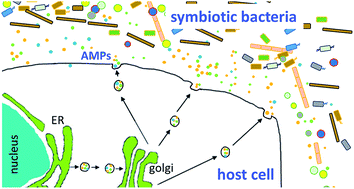Role of antimicrobial peptides in controlling symbiotic bacterial populations
Abstract
Covering: up to 2018
Antimicrobial peptides (AMPs) have been known for well over three decades as crucial mediators of the innate immune response in animals and plants, where they are involved in the killing of infecting microbes. However, AMPs have now also been found to be produced by eukaryotic hosts during symbiotic interactions with bacteria. These symbiotic AMPs target the symbionts and therefore have a more subtle biological role: not eliminating the microbial symbiont population but rather keeping it in check. The arsenal of AMPs and the symbionts' adaptations to resist them are in a careful balance, which contributes to the establishment of the host-microbe homeostasis. Although in many cases the biological roles of symbiotic AMPs remain elusive, for a number of symbiotic interactions, precise functions have been assigned or proposed to the AMPs, which are discussed here. The microbiota living on epithelia in animals, from the most primitive ones to the mammals, are challenged by a cocktail of AMPs that determine the specific composition of the bacterial community as well as its spatial organization. In the symbiosis of legume plants with nitrogen-fixing rhizobium bacteria, the host deploys an extremely large panel of AMPs – called nodule-specific cysteine-rich (NCR) peptides – that drive the bacteria into a terminally differentiated state and manipulate the symbiont physiology to maximize the benefit for the host. The NCR peptides are used as tools to enslave the bacterial symbionts, limiting their reproduction but keeping them metabolically active for nitrogen fixation. In the nutritional symbiotic interactions of insects and protists that have vertically transmitted bacterial symbionts with reduced genomes, symbiotic AMPs could facilitate the integration of the endosymbiont and host metabolism by favouring the flow of metabolites across the symbiont membrane through membrane permeabilization.

- This article is part of the themed collection: The Chemistry of Symbiotic Interactions


 Please wait while we load your content...
Please wait while we load your content...